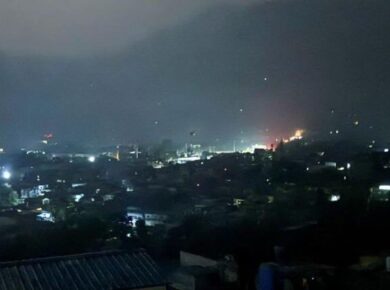Atmosphere – Evaporation, Humidity, Condensation, Precipitation
Evaporation
- Process by which water or a liquid is transformed from liquid to gaseous or vapours state
- Evaporation increases with temp., dryness & movement of air
- Evaporation decreases with cloud cover
- Evaporation of Water → 64 % by Transpiration + 6 % by Soil Evaporation + 3 % by from water bodies
Humidity
- Defined as amount of water vapour present in air
- At any specific temp., amount of water vapour that can be held by air has a definite limit known as saturation point
- Air at saturation point is known as saturated air.
- Temperature at which saturation occurs is known as Dew point
- Capacity of air to absorb water vapour increases with increase in temperature
| Absolute Humidity | gm / m3 | Weight of actual amount of water vapour present in unit volume of air |
| Specific Humidity | gm / kg |
|
| Relative Humidity | Expressed in % |
|
Condensation
- Defined as transformation of water vapour into water, caused by loss of heat when moist air is cooled.
- Cooling may reach a level when air’s capacity to hold water vapour ceases, then excess of water vapour condenses into liquid form
- If water vapour directly condenses into solid form, it is known as sublimation
- In free air, condensation results from cooling around very small particles termed as condensation nuclei
- Particle of dust, smoke & salt from oceans are particularly good nuclei as they absorb water (Hygroscopic nuclei)
Condensation takes places when –
- of air is reduced to dew pt. with its volume remaining constant
- When both air’s temp. & volume are reduced
- Moisture is added to air through evaporation
Form of Condensation
Dew
- Forms when moisture is deposited in form of water droplets on cooler surfaces of solid objects such as stone, glass, blades, plant leaves etc. rather than on nuclei in air above
- Forms when temperature of air falls below dew point but above freezing point
Frost
- Forms on solid surfaces when condensation takes place below freezing point i.e. 0*C
- Means dew point is at or below freezing point
Fog & Mist
- When temp. of an air mass containing large quantity of water vapour falls all of a sudden, condensation takes place on fine dust & smoke particles
- So, fog is basically a cloud with its base at or very near to ground
- Only difference b/w fog & mist is that mist contains more moisture than fog & each nuclei in mist contains thicker layer of moisture
- Fog is formed generally when warm & cold currents meet
- Mist is formed frequently over the mountains when rising warm air up the slopes meet cold surfaces
Smog
- In urban & industrial areas, smoke provides plenty of nuclei which helps in the formation of fog & mist
- Such a condition, when fog is mixed with smoke is called smog
Clouds
- It is mass of minute water droplets or tiny crystals of ice formed by condensation of water vapour in free air at considerable elevations
- Formed mainly because of adiabatic cooling of air below its dew point
| Cirrus Clouds |
|
| Cumulus Clouds |
|
| Nimbus Clouds |
|
| Stratus Clouds |
|
Precipitation
- Condensation of water vapor in air in form of water droplets or ice
- Their falling on earth surface is known as precipitation
Snowfall
- When condensation takes place below freezing point
- Means at 0*C, conversion of water vapour directly into solid state
- Precipitation occurs in forms of fine flakes of snow
Sleet
- Sleet is frozen raindrops or refroze melted snow water
- When a layer of temp. above freezing point overlies a subfreezing layer near the ground, precipitation occurs in form of sleet
Hail
- Sometimes, drops of rains after being released by the clouds become solidified into small rounded stone pieces of ice, known as hailstones
- Formed by rainwater passing through colder layers hence have several concentric layers of ice, one over the another
Rainfall
- Most common form of precipitation
- Precipitation in form of water
- Also known as cloud particles
Types of Rainfall
Convectional Rainfall
- Air on being heated becomes light & rises up as conventional currents
- As it rises, it loses heat & consequently condensation takes place with the formation of cumulus clouds.
- Under these conditions, heavy rainfall takes place along with thunder & lightening, but does not last for long
- Common in Equatorial & Tropical regions in summers daily
Orographic / Relief Rainfall
- When a warm & moist air currents is obstructed by a mountain range, it is forced to ascent along its slopes
- It gets cooled while ascending & when its temp. falls below dew point, it causes rainfall on windward slope of mountain range
- However, when these winds cross mountain range & descend along its leeward side
- Here, they get warm & dry & causes only little rain (Rain shadow areas)
- This type of rainfall may occur in any season
Cyclonic / Frontal Rainfall
- Rainfall associated with cyclone is known as cyclonic/ frontal rainfall
- Occurs along the fronts of the cyclone viz. cold front & warm front
- At the warm front, the warm lighter wind rises gently over the heavier cold air, which being heavy stays close to the ground
- As the warm air rises, it cools, and the moisture present in it condenses to form clouds altostratus clouds
- This rain falls steadily for a few hours to a few days.















1 comment
thankyou very much to share the knowledge.